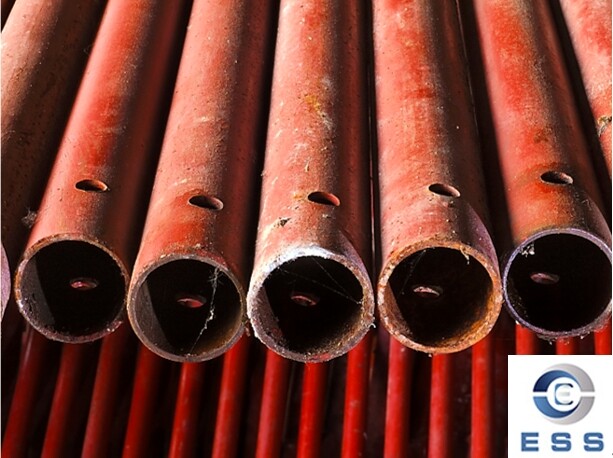
Boiler
tube refers to steel materials with openings at both ends and a hollow
section, with a larger length than the circumference. According to the
production method, they can be divided into seamless
steel pipe and welded
steel pipe. They are the key components of boilers. Choosing suitable
boiler tubes not only directly affects the service life and efficiency of the
boiler, but also is related to the quality of production and life.
General boiler tube model chart
|
Model
|
Material
|
Diameter(mm)
|
Wall Thickness(mm)
|
Length(m)
|
|
20G
|
Iron
|
51
|
5.5
|
6-12
|
|
20MnG
|
Iron
|
51
|
5.5
|
6-12
|
|
25MnG
|
Iron
|
51
|
5.5
|
6-12
|
|
15CrMoG
|
Iron
|
51
|
5.5
|
6-12
|
|
12Cr1MoVG
|
Iron
|
51
|
5.5
|
6-12
|
|
12Cr2MoG
|
Iron
|
51
|
5.5
|
6-12
|
|
10Cr9Mo1VNb
|
Iron
|
51
|
5.5
|
6-12
|
|
1Cr18Ni9Ti
|
Stainless
Steel
|
51
|
5.5
|
6-12
|
|
1Cr18Ni9Ti
|
Stainless
Steel
|
76
|
6.0
|
6-12
|
|
1Cr18Ni9Ti
|
Stainless
Steel
|
89
|
6.0
|
7-12
|
General boiler tube size chart
|
Material
|
Diameter(mm)
|
Wall Thickness(mm)
|
|
Iron
|
51
|
5.5
|
|
Iron
|
57
|
6.0
|
|
Iron
|
60
|
6.0
|
|
Iron
|
63.5
|
8.0
|
|
Iron
|
76
|
7.0
|
|
Iron
|
89
|
8.0
|
|
Stainless
Steel
|
51
|
5.5
|
|
Stainless
Steel
|
76
|
6.0
|
|
Stainless
Steel
|
89
|
6.0
|
General boiler tube parameter chart
|
Model
|
Main Material
|
Tensile Strength(MPa)
|
Yield Strength(MPa)
|
Elongation(%)
|
Hardness(HB)
|
|
20G
|
Iron
|
410-550
|
≥245
|
≥24
|
≤179
|
|
20MnG
|
Iron
|
415-550
|
≥245
|
≥22
|
≤179
|
|
25MnG
|
Iron
|
450-600
|
≥275
|
≥22
|
≤217
|
|
15CrMoG
|
Iron
|
440-640
|
≥235
|
≥21
|
≤207
|
|
12Cr1MoVG
|
Iron
|
470-640
|
≥255
|
≥21
|
≤241
|
|
12Cr2MoG
|
Iron
|
450-600
|
≥280
|
≥20
|
≤255
|
|
10Cr9Mo1VNb
|
Iron
|
585-780
|
≥415
|
≥20
|
≤255
|
|
1Cr18Ni9Ti
|
Stainless
Steel
|
≥520
|
≥205
|
≥40
|
≤187
|
General boiler tube specification chart
|
Material
|
Range
|
|
Iron
|
Φ51x5.5-6.0x6-12m
|
|
Iron
|
Φ57x6.0-7.0x6-12m
|
|
Iron
|
Φ60x6.0-7.0x6-12m
|
|
Iron
|
Φ63.5x8.0x6-12m
|
|
Iron
|
Φ76x7.0-8.0x6-12m
|
|
Iron
|
Φ89x8.0-10x7-12m
|
|
Stainless
Steel
|
Φ51x5.5-6.0x6-12m
|
|
Stainless
Steel
|
Φ76x6.0-8.0x6-12m
|
|
Stainless
Steel
|
Φ89x6.0-8.0x7-12m
|
Selection considerations
1. Flow rate
The flow rate of the boiler tube should be
selected according to the required heat output and water circulation volume.
Too large or too small flow rate will affect the normal operation of the
boiler.
2. Pressure
The pressure of the boiler tube should take
into account the maximum pressure and temperature of the boiler during
operation, as well as the bearing capacity of the pipeline material. Choosing
too low a pressure will cause the pipeline to burst, and too high a pressure
will cause rupture.
3. Material
The material of the boiler tube should be
selected according to factors such as fuel, medium, pressure and temperature.
Commonly used materials include carbon steel, alloy steel, stainless steel,
etc.
4. Safety valve
The boiler tube must be equipped with a
safety valve and a pressure reducing valve to ensure the safe operation of the
pipeline.
5. Size
The size of the boiler tube should be
selected according to the above factors, and the larger the size, the higher
the cost of the pipeline. For some small boilers, smaller pipelines can be
selected.
Summary
The selection of boiler tubes should
consider many factors, including flow rate, pressure, material and size.
Choosing the right size, parameters and specifications can ensure the safe
operation of the pipeline and the normal operation of the boiler. In actual
operation, appropriate pipe specifications and materials should be selected
according to specific circumstances to ensure smooth operation of the boiler
tube.













 Eastern Steel Manufacturing Co.,Ltd not only improve product production and sales services, but also provide additional value-added services. As long as you need, we can complete your specific needs together.
Eastern Steel Manufacturing Co.,Ltd not only improve product production and sales services, but also provide additional value-added services. As long as you need, we can complete your specific needs together.










